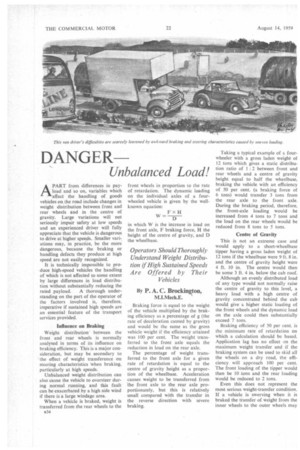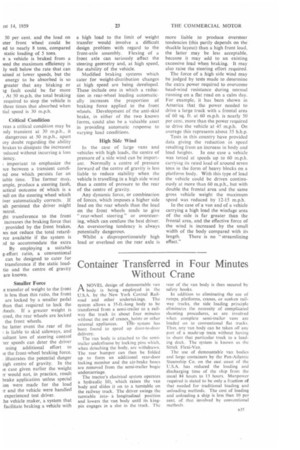DANGER
Page 68

Page 69

If you've noticed an error in this article please click here to report it so we can fix it.
Unbalanced Load!
By p. A. C. Brocidngpn, M.I.Mech.E. APART from differences in payload and so on, variables which affect the handling of goods vehicles on the road include changes in weight distribution between front and rear wheels and in the centre of gravity. Large variations will not seriously impair safety at low speeds and an experienced driver will fully appreciate that the vehicle is dangerous to drive at higher speeds. Smaller variations may, in practice, be the more dangerous, because the braking or handling defects they produce at high speed are not easily recognized.
It is technically impossible to produce high-speed vehicles the handling of which is not affected to some extent by large differences in load distribution without substantially reducing the
rated payload. A thorough understanding on the part of the operator of the factors involved is, therefore, imperative if sustained high speeds are an essential feature of the transport services provided.
Influence on Braking
Weight distribution between the front and rear wheels is normally analysed in terms of its influence on braking efficiency. This is a major consideration, but may be secondary to • the effect of weight transference on steering characteristics •when braking, particularly at high speeds.
Unbalanced weight distribution can also cause the vehicle to oversteer during normal running, and this fault can be exacerbated by a high side wind if there is a large windage area.
When a vehicle is braked, weight is transferred from the rear wheels to the B34 front wheels in proportion to the rate of retardation. The dynamic loading on the individual axles of a fourwheeled vehicle is given by the wellknown equation: Fx H
W= in which W is the increase in load on the front axle, F braking force, H the height of the centre of gravity, and D the wheelbase.
Operators Should Thoroughly Understand Weight Distribution if High Sustained Speeds Are Offered by Their Vehicles
Braking force is equal to the weight of the vehicle multiplied by the braking efficiency as a percentage of g (the rate of deceleration caused by gravity) and would be the same as the gross vehicle weight if the efficiency attained was 100 per cent. The weight transferred to the front axle equals the reduction in load on the rear axle.
The percentage of weight transferred to the front axle for a given rate of retardation is equal to the centre of gravity height as a proportion of the wheelbase. Acceleration causes weight to be transferred from The front axle to the rear axle proportionately, but this is relatively small compared with the transfer in the reverse direction with severe braking. Taking a typical example of a fourwheeler with a gross laden weight of 12 tons which gives a static distribution ratio of 1 : 2 between front and rear wheels and a centre of gravity height equal to half the wheelbase, braking the vehicle with an efficiency of 50 per cent. (a braking force of 6 tons) would transfer 3 tons from the rear axle to the front axle. During the braking period, therefore, the front-axle loading would be increased from 4 tons to 7 tons and the load on the rear wheels would be reduced from 8 tons to 5 tons.
Centre of Gravity
This is not an extreme case and would apply to a short-wheelbase tipper having a gross laden weight of 12 tons if the wheelbase were 9 ft. 8 in. and the centre of gravity height were 4 ft. 10 in. The centre would then be some 3 ft. 4 in. below the cab roof.
Although an evenly distributed load of any type would not normally raise the centre of gravity to this level, a heavy load with a high centre of gravity concentrated behind the cab would give a higher static loading of the front wheels and the dynamic load on the axle could then substantially exceed 7 tons.
Braking efficiency of 50 per cent, is the minimum rate of retardation on which a calculation should be based. Application Tag has no effect on the maximum weight transfer and if the braking system can be used to skid all the wheels on a dry road, the efficiency will approach 100 per cent. The front loading of the tipper would then be 10 tons and the rear loading would be reduced to 2 tons.
Even this does not represent the most serious weight-transfer condition. If a vehicle is swerving when it is braked the transfer of weight from the inner wheels to the outer wheels may 50 per cent, and the load on titer front wheel could be ed to nearly 8 tons, compared static loading of 5 tons.
n a vehicle is braked from a teed the maximum efficiency is ly well below the rate that can ained at lower speeds, but the energy to be absorbed is so greater that any braking or ig fault could be far more . At 50 m.p.h. the total braking required to stop the vehicle is three times that absorbed when tial speed is 30 m.p.h.
Critical Condition reas a critical condition may be ssly transient at 30 m.p.h., it dangerous at 50 m.p.h., apart my doubt regarding the ability brakes to dissipate the increased -oduced without incurring a loss iency.
; important to emphasize the ice between a transient condind one which persists for an iable time. The former may, tmple, produce a steering fault, actical outcome of which is a mil on the steering wheel which iver automatically corrects. If tilt persisted the driver might ;tit transference to the front increases the braking force that provided by the front brakes, tes not reduce the total retardrce available if the system is xi to accommodate the extra By employing a suitable g-effort ratio, a conventional can be designed to cater for transference if the static loadtio and the centre of gravity are known.
Smaller Force e transfer of weight to the front is less than this ratio, the front are locked by a smaller pedal than that required to lock the /heels. If a greater weight is Tred, the rear wheels are locked the front wheels, he latter event the .rear of the : is liable to skid sideways, and sultant loss of steering control ler speeds can deter the driver using additional effort to te the front-wheel braking force. illustrates the potential danger ugh centre of gravity. In the ie case given earlier the weight T would not, in practice, result brake application unless special on were made for the load T and the vehicle were handled experienced test driver.
.he vehicle maker, a system that facilitate braking a vehicle with a high load to the limit of weight transfer would involve a difficult design problem with regard to the front-axle assembly_ Flexing of a front axle can seriously affect the steering geometry and, at high speed, the stability of the vehicle.
Modified braking systems which cater for weight-distribution changes at high speed are being developed. These include one in which a reduction in rear-wheel loading automatically increases the proportion of braking force applied to the front wheels. Development of the anti-skid brake, in either of the two known forms, could also be a valuable asset in providing automatic response to varying load conditions.
High Side Wind In the case of large vans and vehicles with high loads, the centre of pressure of a side wind can be important. Normally a centre of pressure forward of the centre of gravity is less liable to reduce stability when the vehicle is travelling in a high side wind than a centre of pressure to the rear of the centre of gravity.
Any dynamic force, or combination of forces, which imposes a higher side load on the rear wheels than the load on the front wheels tends to give " rear-wheel steering" or oversteering, which can confuse the best driver. An oversteering tendency is always potentially dangerous.
Whilst a disproportionately high load or overload on the rear axle is
more liable to produce oversteer tendencies (this partly depends on the shackle layout) than a high front load, the latter may be less acceptable. because it may add to an existing excessive load when braking. It may also raise the steering effort required.
The force of a high side wind may be judged by tests made to determine the extra power required to overcome head-wind resistance during normal running on a flat road on a calm day. For example, it has been shown in America that the power needed to drive a large truck with a frontal area of 60 sq. ft. at 60 m.p.h. is nearly 50 per cent. more than the power required to drive the vehicle at 45 m.p.h. On average this represents about 55 b.h.p.
Tests in this country have provided data giving the reduction in speed resulting from an increase in body and load heights. In one case a vehicle was tested at speeds up to 60 m.p.h. carrying its rated load of around seven tons in the form of heavy blocks on a platform body. With this type of load the vehicle could be driven continuously at more than 60 m.p.h., but with double the frontal area and the same gross vehicle weight the maximum speed was reduced by 12-15 m.p.h.
In the case of a van and of a vehicle carrying a high load the windage area of the side is far greater than the frontal area, and the effective force of the wind is increased by the small width of the body compared with its
length. There is no "streamlining effect."




















































































































